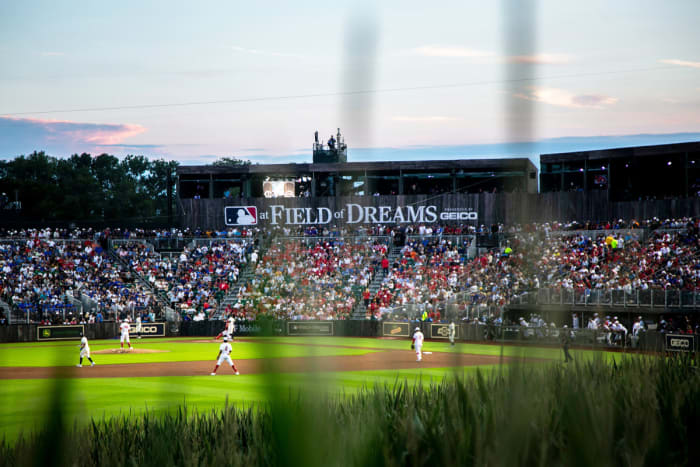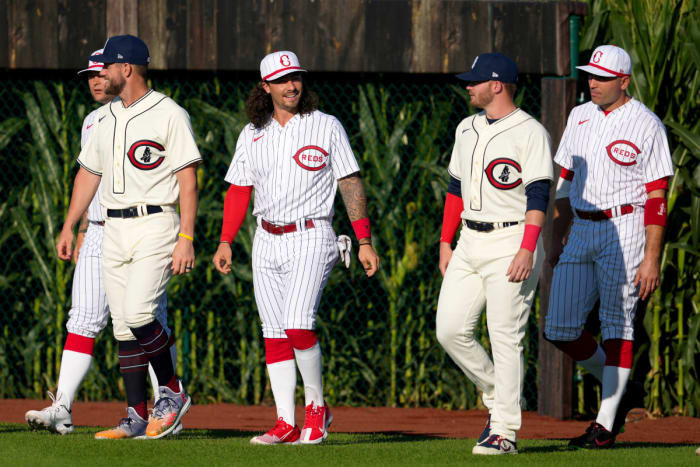DYERSVILLE, Iowa — I stepped into an elevator at the Hotel Julien in Dubuque, Iowa, and so did Timothy Busfield.
“Been here before?” a friend traveling with Busfield asked me.
“Yes, I was here last year,” I said. I turned to Busfield with a wink and asked, “And you? I imagine you’ve been here before.”
“Um, a time or two,” he said with a sly grin.
Busfield played as close to a villain as Field of Dreams would allow. A nonbeliever, he played Mark, the brother-in-law of Ray Kinsella (Kevin Costner) who believes in a voice telling him to turn part of his corn crop into a baseball field. Busfield once said he built his entire character on one line: “When did all these ballplayers get here?” Knowing that Mark would become a believer, Busfield leaned into the power of doubt, even outright dismissal.

Played in an 8,000-seat bandbox amid Iowa charm and hospitality, the “Field of Dreams” game is a needed reminder of baseball’s humble and familial roots.
Joseph Cress/Iowa City Press-Citizen/USA TODAY Sports Network
The second Field of Dreams game Thursday night tested our belief in baseball and the dreams it harbors. Lacking the novelty of the game last year, not to mention the star power of Costner, Aaron Judge, Giancarlo Stanton and Tim Andersonthe game between the Cubs and Reds faced the same challenge of every sequel: living up to expectations. Take two losing teams in which 11 of the starting 18 players earn less than $800,000 a year, and you’re risking Caddyshack II.
For the record, the Cubs beat the Reds 4-2 without a single home run landing in all that corn surrounding the park. (The Yankees and White Sox hit eight in the Field of Dreams game last year.)
There will be no return trip to Iowa next year. That’s only because the place will be under construction as it reinvents itself into a massive youth baseball complex. And it might not be in 2024, either, as MLB looks to bring its product to other unique places, such as Rickwood Field in Birmingham, Ala., built in 1910 and home to the Black Barons of the Negro American League from ’20 to ’60, including a stint by Willie Mays in ’48.
But whether it lives as an annual event or exists in a rotation of sorts, the Field of Dreams game should always have a regular turn at bat in the baseball schedule. The movie is that embedded in American culture and the game itself. Played in an 8,000-seat bandbox amid Iowa charm and hospitality, it is a needed reminder of baseball’s humble and familial roots.
Manager David Ross called it “needed perspective” when, as the Cubs were rolling in on buses to an out-of-the-way venue, people lined the route excitedly waving to them from their driveways or atop their tractors—just to see buses filled with major leaguers zip by.
“You see what baseball means to people,” he says.
Amid thirst for ratings and likes and marquee names, why can’t there be one night in a long season given to charm, nostalgia and family? That’s the future of the Field of Dreams game. Give other teams the chance to experience what the Cubs and Reds did: to walk on this meticulous carpet of grass in vintage uniforms taking video with their cellphones as if awed and even humbled by the simplicity of the setting. Once even the most jaded MLB players get here, they can’t help but smile.
Busfield played high school ball in Michigan, junior college ball in Florida and semipro ball in Sacramento. He is an accomplished actor and director who found gold being part of the magic of Field of Dreams, which has become a franchise without a sequel. He once said his favorite line not his own in the movie belongs to Costner, who upon facing Shoeless Joe Jackson has the audacity to say, “See if you can hit my curve.” The line is full of bravado, a swelling of belief. Jackson, played by the late Ray Liotta, rips the curveball off the ball bag next to Costner, sending Costner splaying to the ground. As Costner pointed out upon Liotta’s death, the scene happened organically just like that. Such was the magic that summer of 1988 in Dyersville.
Director Phil Robinson did not want special effects or gimmicky lighting. When Shoeless Joe first appears out of the cornfield, a rare summer fog had formed around the set, creating the perfect atmospherics. We’re talking about a movie in which the climactic scene is not an explosion or car chase or death or mayhem, but a simple game of catch between father and son. That scene, too, had no special effects. Robinson shot it during “magic hour,” the last hour of daylight. Somehow it all worked. Ross, who has seen the movie many times, said he saw it again recently with his children and cried during that scene.
Liotta first read the script and thought it was “silly.” He took the gig because he had only made two movies, and he needed the job. Later, he would admit about his first impression, “I was wrong.”
The movie was about baseball, yes, but it has lasted as an American institution because it was about belief in something, and about the connections we make and those that end. A game of catch is about connecting with someone. It’s about giving more than taking. It is the power of a shared experience. And that power turns plaintive when we can no longer connect—to play catch—with the ones we love.

The Cubs and Reds walked on this meticulous carpet of grass in vintage uniforms, awed and humbled by the simplicity of the setting.
Kareem Elgazzar/The Enquirer/USA TODAY Sports Network
Such are simple themes, and therein lies the beauty of Field of Dreams, the movie and the MLB game. If all you want is the spectacular, you will be disappointed more than rewarded. You will be Mark the cynic, rather than Mark the believer. But if you cherish the small moments, when time slows so much it appears to stop, then you understand why the Field of Dreams game is worth becoming a baseball tradition.
Sign up for the Five-Tool Newsletter to get all our MLB coverage in your inbox every Friday during the 2022 season.
More MLB Coverage:
• Is Patrick Corbin Having the Worst Pitching Season Ever?
• The White Sox Are Sleeping Away Their Once Promising Season
• A Cautiously Optimistic Cody Bellinger Update
• The Most Interesting Under-the-Radar Trade Deadline Deals
• The Beautiful Life of Vin Scully
.